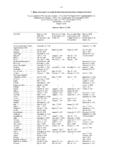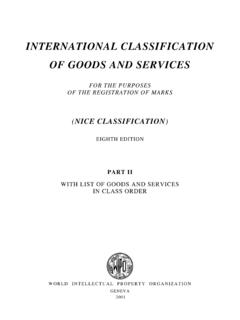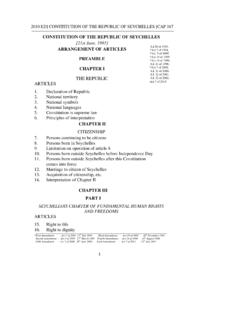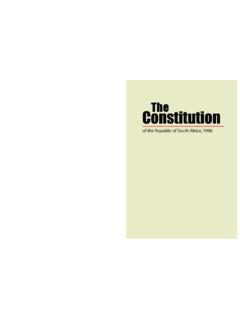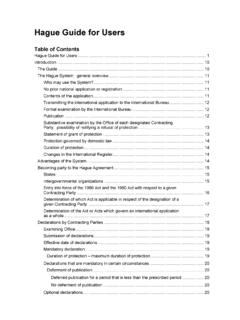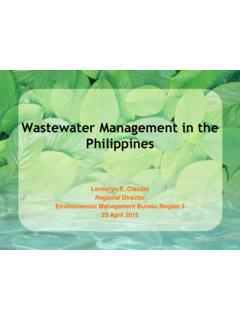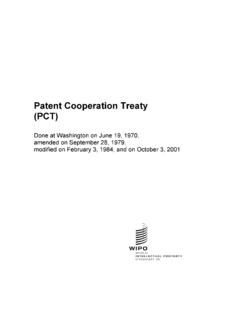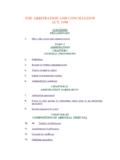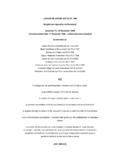Transcription of INTERNATIONAL CLASSIFICATION OF GOODS AND …
1 INTERNATIONAL CLASSIFICATION . OF GOODS AND SERVICES. FOR THE PURPOSES. OF THE registration OF MARKS. (NICE CLASSIFICATION ). EIGHTH EDITION. PART II. WITH LIST OF GOODS AND SERVICES. IN CLASS ORDER. WORLD INTELLECTUAL PROPERTY ORGANIZAT ION. GENEVA. 2001. All rights reserved. No part of this publication may be reproduced in any form or by any means (electronically, mechanically, by photocopying, recording or otherwise) without the prior permission of the copyright owner. WIPO PUBLICATION. No. (E). _____. ISBN 92-805-0938-1. CONTENTS. Page Preface .. (v). Nice agreement concerning the INTERNATIONAL CLASSIFICATION of GOODS and Services for the Purposes of the registration of Marks .. (ix). Madrid agreement concerning the INTERNATIONAL registration of Marks (extracts) .. (xix). Protocol Relating to the Madrid agreement (extracts) .. (xxiii). Nice CLASSIFICATION : Guidance for the User .. 1. General Remarks .. 3. Class Headings .. 4. List of Classes, with Explanatory Notes: GOODS .
2 7. Services .. 26. Alphabetical List (in Class order): GOODS .. 35. Services .. 145. * * *. (iii). PREFACE. HISTORY AND PURPOSE OF THE NICE CLASSIFICATION . The INTERNATIONAL (Nice) CLASSIFICATION of GOODS and Services for the Purposes of the registration of Marks was established by an agreement concluded at the Nice Diplomatic Conference, on June 15, 1957, and was revised at Stockholm, in 1967, and at Geneva, in 1977. The countries party to the Nice agreement constitute a Special Union within the framework of the Paris Union for the Protection of Industrial Property. They have adopted and apply the Nice CLASSIFICATION for the purposes of the registration of marks. Each of the countries party to the Nice agreement is obliged to apply the Nice CLASSIFICATION in connection with the registration of marks, either as the principal CLASSIFICATION or as a subsidiary CLASSIFICATION , and has to include in the official documents and publications relating to its registrations of marks the numbers of the classes of the CLASSIFICATION to which the GOODS or services for which the marks are registered belong.
3 Use of the Nice CLASSIFICATION is mandatory not only for the national registration of marks in countries party to the Nice agreement , but also for the INTERNATIONAL registration of marks effected by the INTERNATIONAL Bureau of WIPO, under the Madrid agreement concerning the INTERNATIONAL registration of Marks and under the Protocol Relating to the Madrid agreement concerning the INTERNATIONAL registration of Marks, and for the registration of marks by the African Intellectual Property Organization (OAPI), by the Benelux Trademark Office and by the Office for Harmonization in the Internal Market (Trade Marks and Designs) (OHIM). The Nice CLASSIFICATION is also applied in a number of countries not party to the Nice agreement (see list on page (viii)). REVISIONS OF THE NICE CLASSIFICATION . The Nice CLASSIFICATION is based on the CLASSIFICATION prepared by the United INTERNATIONAL Bureaux for the Protection of Intellectual Property (BIRPI) predecessor of WIPO in 1935. It was that CLASSIFICATION , consisting of a list of 34 classes and an alphabetical list of GOODS , that was adopted under the Nice agreement and later expanded to embrace also eleven classes covering services and an alphabetical list of those services.
4 The Nice agreement provides for the setting up of a Committee of Experts in which all countries party to the agreement are represented. The Committee of Experts decides on all changes in the CLASSIFICATION , in particular the transfer of GOODS and services between various classes, the updating of the alphabetical list and the introduction of necessary explanatory notes. (v). The Committee of Experts has, since the entry into force of the Nice agreement , on April 8, 1961, held 18 sessions and has, amongst its most noticeable achievements, undertaken a general review of the Alphabetical List of GOODS and services from the point of view of form (in the late 1970s); substantially modified the General Remarks, the Class Headings and the Explanatory Notes (in 1982); introduced a basic number for each single product or service in the Alphabetical List (in 1990), which number enables the user to find the equivalent product or service in the alphabetical lists of other language versions of the CLASSIFICATION ; and revised Class 42 with the creation of Classes 43 to 45 (in 2000).
5 At its eighteenth session, held in October 2000, the Committee of Experts adopted changes to the seventh edition of the Nice CLASSIFICATION . EDITIONS OF THE NICE CLASSIFICATION . The first edition of the Nice CLASSIFICATION was published in 1963, the second in 1971, the third in 1981, the fourth in 1983, the fifth in 1987, the sixth in 1992 and the seventh in 1996. This edition (the eighth), published in June 2001, will enter into force on January 1, 2002. * * *. The authentic versions of the Nice CLASSIFICATION (English and French) are published in two parts. Part I lists, in alphabetical order, all the GOODS in one list and all the services in another list. Part II (this volume) lists, in alphabetical order for each class, the GOODS or services belonging to that class. There is also a version with a bilingual (English/French). alphabetical list. The eighth edition of the Nice CLASSIFICATION may be ordered from the World Intellectual Property Organization (WIPO), 34, chemin des Colombettes, Box 18, CH-1211 Geneva 20.
6 Geneva, June 2001. (vi). COUNTRIES PARTY TO THE NICE agreement . (December 2000). Algeria Luxembourg Australia Malawi Austria Mexico Barbados Monaco Belarus Morocco Belgium Netherlands Benin Norway Bosnia and Herzegovina Poland Bulgaria Portugal China Republic of Korea Croatia Republic of Moldova Cuba Romania Czech Republic Russian Federation Democratic People's Republic of Korea Saint Lucia Denmark Singapore Dominica Slovakia Estonia Slovenia Finland Spain France Suriname Germany Sweden Greece Switzerland Guinea Tajikistan Hungary The former Yugoslav Iceland Republic of Macedonia Ireland Trinidad and Tobago Israel Tunisia Italy Turkey Japan Ukraine Kyrgyzstan United Kingdom Latvia United Republic of Tanzania Lebanon United States of America Liechtenstein Uruguay Lithuania Yugoslavia (Total: 65 countries). (vii). OTHER COUNTRIES AND ORGANIZATIONS USING THE. NICE CLASSIFICATION . (December 2000). In addition to the 65 countries party to the Nice agreement , listed on the previous page, the following 71 countries and three organizations also use the Nice CLASSIFICATION :1.
7 Albania Jamaica Seychelles Angola Jordan Sierra Leone Argentina Kazakhstan Solomon Islands Bahrain Kenya South Africa Bangladesh Kuwait Sri Lanka Bolivia Lesotho Sudan Botswana Libya Swaziland Brazil Madagascar Thailand Burundi Malaysia Tonga Chile Malta Uganda Colombia Mauritius United Arab Emirates Costa Rica Mongolia Venezuela Cyprus Namibia Viet Nam Djibouti Netherlands Antilles Yemen Ecuador New Zealand Zaire Egypt Nicaragua Zambia El Salvador Nigeria Zimbabwe Ethiopia Pakistan African Intellectual Ghana Panama Property Organization Guatemala Paraguay (OAPI)1. Guyana Peru Benelux Trademark Haiti Philippines Office (BBM). Honduras Qatar Office for Harmonization in India Rwanda the Internal Market Indonesia Samoa (OHIM). Iran (Islamic Republic of) San Marino Iraq Saudi Arabia 1. The following States are members of the African Intellectual Property Organization (OAPI). (December 2000): Benin (also party to the Nice agreement ), Burkina Faso, Cameroon, Central African Republic, Chad, Congo, C te d'Ivoire, Equatorial Guinea, Gabon, Guinea (also party to the Nice agreement ), Guinea-Bissau, Mali, Mauritania, Niger, Senegal, Togo (16).
8 (viii). Nice agreement _____. NICE agreement . concerning THE INTERNATIONAL CLASSIFICATION OF. GOODS AND SERVICES FOR THE PURPOSES OF THE. registration OF MARKS. of June 15, 1957, as revised at Stockholm on July 14, 1967, and at Geneva on May 13, 1977, and as amended at Geneva on September 28, 1979. Article 1. Establishment of a Special Union; Adoption of an INTERNATIONAL CLASSIFICATION ;. Definition and Languages of the CLASSIFICATION (1) The countries to which this agreement applies constitute a Special Union and adopt a common CLASSIFICATION of GOODS and services for the purposes of the registration of marks (hereinafter designated as the CLASSIFICATION ). (2) The CLASSIFICATION consists of: (i) a list of classes, together with, as the case may be, explanatory notes;. (ii) an alphabetical list of GOODS and services (hereinafter designated as the alphabetical list ) with an indication of the class into which each of the GOODS or services falls. (3) The CLASSIFICATION comprises: (i) the CLASSIFICATION published in 1971 by the INTERNATIONAL Bureau of Intellectual Property (hereinafter designated as the INTERNATIONAL Bureau ) referred to in the Convention Establishing the World Intellectual Property Organization, it being understood, however, that the explanatory notes to the list of classes included in that publication shall be regarded as provisional and as recommendations until such time as explanatory notes to the list of classes are established by the Committee of Experts referred to in Article 3.
9 (ii) the amendments and additions which have entered into force, pursuant to Article 4(1) of the Nice agreement of June 15, 1957, and of the Stockholm Act of July 14, 1967, of that agreement , prior to the entry into force of the present Act;. (iii) any changes to be made in accordance with Article 3 of this Act and which enter into force pursuant to Article 4(1) of this Act. (4) The CLASSIFICATION shall be in the English and French languages, both texts being equally authentic. (ix). Nice agreement _____. (5)(a) The CLASSIFICATION referred to in paragraph (3)(i), together with those amendments and additions referred to in paragraph (3)(ii) which have entered into force prior to the date this Act is opened for signature, is contained in one authentic copy, in the French language, deposited with the Director General of the World Intellectual Property Organization (hereinafter designated respectively the Director General and the Organization ). Those amendments and additions referred to in paragraph (3)(ii) which enter into force after the date this Act is opened for signature shall also be deposited in one authentic copy, in the French language, with the Director General.
10 (b) The English version of the texts referred to in subparagraph (a) shall be established by the Committee of Experts referred to in Article 3 promptly after the entry into force of this Act. Its authentic copy shall be deposited with the Director General. (c) The changes referred to in paragraph (3)(iii) shall be deposited in one authentic copy, in the English and French languages, with the Director General. (6) Official texts of the CLASSIFICATION , in Arabic, German, Italian, Portuguese, Russian, Spanish and in such other languages as the Assembly referred to in Article 5 may designate, shall be established by the Director General, after consultation with the interested Governments and either on the basis of a translation submitted by those Governments or by any other means which do not entail financial implications for the budget of the Special Union or for the Organization. (7) The alphabetical list shall mention, opposite each indication of GOODS or services, a serial number that is specific to the language in which the said list is established, together with: (i) in the case of the alphabetical list established in English, the serial number mentioned in respect of the same indication in the alphabetical list established in French, and vice versa.
